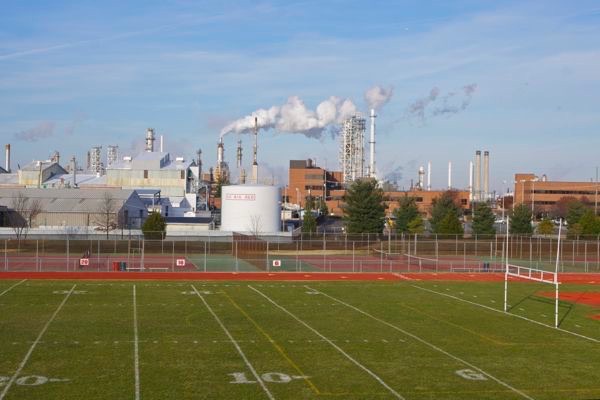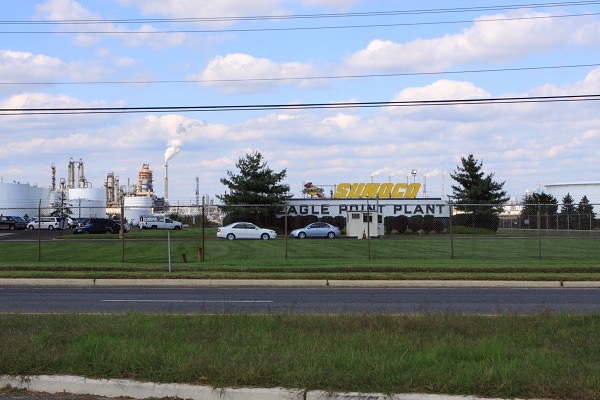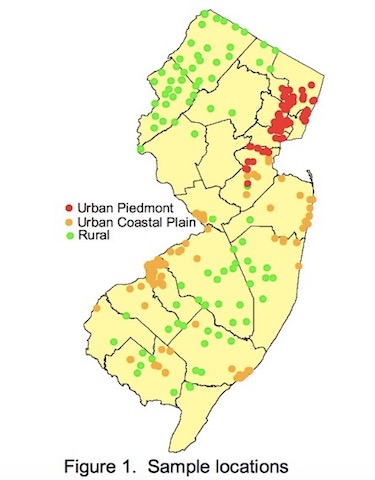Legislative amendments jeopardize DEP’s authority to regulate methane
Gov. Murphy Invites Legislative Veto of DEP Climate Regulations
In my prior post, I explained how DEP’s recent renewal of a natural gas power plant’s air permit completely ignored climate change, perpetuated fossil energy infrastructure, and belied Gov. Murphy’s purported commitments to reduce greenhouse gas emissions.
But, the situation is actually far worse than that.
Today, I’d like to raise some troubling questions about Gov. Murphy’s recent signature of climate legislation.
Before I get to that set of issues, however, I’ll start off by linking the Gov.s signature of that law with DEP’s recent approval of the natural gas power plant permit. My intent is to expose a long running campaign of deception – which we have dubbed an “elite charade” – by illustrating how the recent DEP natural gas plant permit also contradicts Gov. Murphy’s recent approval of legislation alleged to accelerate the emission reduction goals of the Global Warming Response Act.
NJ Spotlight reported on the Governor’s signing of that law on July 24, 2019, see:
The Spotlight story highlighted a strong difference of opinion on the bill:
One activist calls measure to reduce greenhouse-gas emissions in New Jersey ‘really significant’ while another says it falls far short of efforts by other states
The one “activist” who finds the law “really significant” is Tom Gilbert of Rethink NJ and the other is Jeff Tittel of Sierra Club.
I wouldn’t call Gilbert an “activist”. He’s a timid, compromised, corporate styled insider political dealer.
And Spotlight obfuscates the issues and went easy on both the Gov. and Gilbert in framing the disagreement. They always go easy on Gilbert, because he is part of the “cool corporate kids” funded by the same Foundations that fund Spotlight.
Tittel didn’t say the law “falls far short”. He actually said it is “just spin without any substance”. And Tittel was NOT referring to “efforts by other states”. He was referring to NJ and Gov. Murphy.
There is a huge gulf between “really significant” and “just spin without any substance“. What explains that?
NJ Spotlight – funded by the same corporate dominated foundations paying Gilbert’s salary – won’t go there, but we will.
We previously called that legislation a “fake solution” and prior to that we blasted Tom Gilbert of Rethink NJ for his incompetence and dishonesty (see: Tom Gilbert of Rethink NJ Is Lying About Climate Change Legislation), so its pretty clear where we stand.
But let’s look at what Tom Gilbert actually said about the critical issue of DEP’s regulatory authority over greenhouse gas emissions, particularly in light of the DEP’s most recent permit that fails to regulate greenhouse gas emissions.
When the Senate passed the bill, Gilbert said this: (NJ Spotlight)
Other environmental advocates were more optimistic. “This is much needed legislation to ensure the state takes meaningful steps to reduce emissions,’’ said Tom Gilbert, campaign director of Rethink Energy NJ.
He cited provisions requiring the DEP to set benchmarks between now and 2050 for curbing carbon pollution and requiring actions to reduce emissions to achieve the targets if monitoring shows the state will fall short.
When the Governor signed the bill, Gilbert said this: (NJ Spotlight)
Gilbert argued the legislation makes clear the administration plans to regulate greenhouse-gas emissions before the end of Murphy’s term. Clean-energy advocates have long argued the DEP has the legal authority to do so but that the department has been reluctant to do so.
“We are going to see the regulation of greenhouse gas emissions before the completion of the Governor’s first term,’’ Gilbert said. “There couldn’t be any more urgency for us to get it done.’’
Notice how Gilbert uses the word “us”, as if he’s part of and speaking for the Murphy administration.
Notice how Gilbert moved the goalposts: from now to the end of the Gov.’s first term. That’s “urgency”?
By then, DEP will have issued permits to all the pending natural gas pipelines and power plants.
The PennEast pipeline just submitted permit applications to DEP. Other pipelines and power plant permit applications are under DEP review. Under longstanding legal principles of administrative law, permits are reviewed under the regulations in effect at the time of permit application is deemed complete.
The PennEast and other pipeline and power plant permits will be reviewed under current DEP regulations, not those adopted at the end of Gov. Murphy’s first term.
They will be reviewed and issued under current federal EPA rules, not Trump’s EPA’s proposed changes to Section 401 of the Clean Water Act that Gilbert and others are focused on.
How stupid and/or incompetent is Gilbert?
I went into great detail in my “Fake Solution” post to explain why Gilbert’s assessment was false and to outline what a “real solution” would look like:
Regarding actual GHG emissions, Smith’s bill merely requires DEP to develop a “strategy”.
A strategy is NOT an authority to adopt regulations to limit GHG emissions or impose emissions fees on GHG emissions. … (and “benchmarks” and “targets” are not enforceable regulatory standards)
A real solution would be to repeal those 2005 [DEP regulatory] exemptions, close those loopholes, and direct DEP to regulate GHG emissions like other major pollutants (in addition to there policy tools I outlined in that post).
Chairman Smith’s bill does not do any of that and instead proposes the same failed non-regulatory policies of the 2007 GWRA, while diverting attention from real solutions.
Now follow the sequence of events:
Governor Murphy signed the bill on July 23, 2019.
And just days later, on August 5, 2019 – in a move that flat out contradicts the purported intent of the legislation the Gov. signed – DEP issued the permit renewal to the Eagle Point Power Generation LLC plant.
As I’ve written, that permit completely ignored climate change and imposed no restrictions on greenhouse gas emissions (as CO2 or methane).
Yet, Tom Gilbert seems to be the only fool in NJ who can’t seem to understand that he’s been screwed and that he’s been exposed as – at best a cheerleader – and at worst a flat out liar.
On top of all that, Gov. Murphy issued a highly unusual signing statement with that bill:
Today I am pleased to sign Senate Bill No. 3207 (Second Reprint) into law, establishing new timeframes and requirements for the implementation of the Global Warming Response Act. I commend the sponsors of this bill for providing the Department of Environmental Protection with the tools necessary to ensure the State meets our greenhouse gas emission reduction goals by 2050. ….
Although this bill was amended to remove black carbon as a greenhouse gas, black carbon continues to be a short-lived climate pollutant, and will be a part of the State’s comprehensive emissions reduction strategy. Furthermore, I am directing the Department of Environmental Protection to use its existing legal authority, in addition to the authority provided by this bill, to administratively address the reduction of short-lived climate pollutants such as black carbon, which will provide short-term air quality benefits while also reducing climate warming pollutants.
First of all, it is absurd to issue a signing statement regarding a substantive policy disagreement with the Legislature. If Gov. Murphy were serious (instead of spinning) he would have conditionally vetoed the bill and specified language to amend it to satisfy his policy. He didn’t do that (avoiding a legislative battle or expending any political capital).
In essence, what Gov. Murphy is saying to the legislature here is “screw you, I’ll do what I want via executive authority”.
That was a very bad move – both politically and legally – particularly given the fact that the Legislature has power to veto any agency regulation.
Now that Gov. Murphy has stuck his finger in their eye, the Legislature would be justified in exercising that veto power, should DEP propose future regulations on “short lived climate pollutants”, importantly which are not just “black carbon” but also include methane.
Here is why DEP’s authority to regulate methane is now in jeopardy.
The introduced version of the bill defined methane as a “greenhouse gas” and applied to methane as a part of a program governing “short lived climate pollutant” in Section 6.
Section 6 “short lived climate pollutant” DEP authority and program was deleted in its entirely. That section also included a provision preserving DEP’s “existing authority”. Elimination of those provisions creates a very strong legislative intent argument that the DEP doesn’t have any “existing authority” and now lacks statutory authority and legislative intent to regulate methane.
(Recall that the introduced version of the Global Warming Response Act also included authority to DEP to regulate greenhouse gas emissions. That provision also was stripped from the final version of the bill passed by the Legislature and signed by Gov. Corzine. Under the GWRA, DEP is not provided authority to regulate all GHG emissions, not just black carbon and methane.
A standard method of statutory interpretation is to look at what legislatures do after courts decide or regulatory agencies act on a specific issue. If the legislature passes laws that narrow, restrict, or revoke an agency’s regulatory powers – or not recognize or affirm those powers – or establish alternatives to those powers – after the agency has asserted those powers, that is concrete legislative intent that the agency does not in fact possess those powers.
There are now 3 laws on the books – all passed after DEP asserted regulatory authority over greenhouse gas emissions back in 2005 – that limited DEP authority, or stripped DEP authority, or established alternative policies to DEP regulation with respect to DEP authority to regulate GHG emissions. Therefore, that strongly suggests that DEP lacks authority to regulate greenhouse gas emissions and that NJ’s sole policy approach to reducing these emissions is the joint DEP-BPU RGGI allowance trading program or BPU GHG emission portfolio standards (which BPU has NOT implemented.)
The Gov. signing statement doesn’t change these legal facts – it only makes it all worse by providing a political impetus to legislators to defend the integrity and power of the legislative branch. (and Senate President Sweeney opposes DEP regulatory authority on greenhouse gas emissions and would love to embarrass the Gov.)
So, Tom Gilbert is cheerleading for a law that may have crippled DEP’s power to regulate methane, including from pipelines like PennEast. What a damn dangerous fool.
In issuing that signing statement, Gov. Murphy is redolent of George Bush’s signing statements and a warped theory of Executive Power (AKA “The Unitary Executive”).
Here’s what the Brookings Institution concluded about Bush’s signing statements (see: The Threat of Bush’s Signing Statements):
This use of presidential signing statements seems to us clearly to violate the Constitution. Article I of our founding document gives Congress, not the president, the power to make the laws. Article II requires the president to take care that the laws be faithfully executed. The Constitution also gives the president the authority to veto laws that he finds objectionable. And if he does, the Constitution states that Congress may either “override” the veto, in which case it becomes law, or it may sustain it, and the bill will fail.
By signing a particular bill into law and then issuing a signing statement that declares that he will not give effect to it, or to a provision of it, the president effectively circumvents these constitutional requirements, as well as displaces the courts as the final expositor of the Constitution.
Of course, all of this went over the head of the lame NJ press corps and environmental activist, who have serious competence issues.
But, I would have thought that a so called progressive liberal democratic governor acting like a right wing imperial republican in the exercise of this executive power would have attracted the attention of the political press corps or republican legislators.
Guess I expect too much. Ignorance, opportunism, and cowardice rule.
PS – and Tom Gilbert is not the only useful idiot. Here’s another, in a more ritual Bergen Record story:
“These are all important moves, but we need to make sure that DEP develops rules to regulate black carbon,” Goldsmith said. “They have the power to do this. They need to do this.”
[End Note – another legal factor supporting these concerns is the failure of a RGGI bill introduced this session – which would have reformed the program – to be enacted into law. That bill seems to have fallen into a black hole. I’ll track down the details and update this post when I do.



